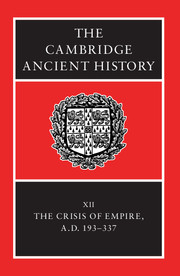Book contents
- Frontmatter
- PART I NARRATIVE
- 1 The Severan dynasty
- 2 Maximinus to Diocletian and the ‘crisis’
- 3 Diocletian and the first tetrarchy, a.d. 284–305
- 4 The Reign of Constantine, a.d. 306–337
- PART II GOVERNMENT AND ADMINISTRATION
- PART III THE PROVINCES
- PART IV THE ECONOMY OF THE EMPIRE
- PART V THE NON-ROMAN WORLD
- PART VI RELIGION, CULTURE AND SOCIETY
- Chronology
- Bibliography
- Index
- Topographical map of the Roman empire
- Map 2 The Roman empire in a.d. 211
- The Roman empire in a.d. 314
- The Rhine–Danube limes in the late second century
- References
2 - Maximinus to Diocletian and the ‘crisis’
from PART I - NARRATIVE
Published online by Cambridge University Press: 28 March 2008
- Frontmatter
- PART I NARRATIVE
- 1 The Severan dynasty
- 2 Maximinus to Diocletian and the ‘crisis’
- 3 Diocletian and the first tetrarchy, a.d. 284–305
- 4 The Reign of Constantine, a.d. 306–337
- PART II GOVERNMENT AND ADMINISTRATION
- PART III THE PROVINCES
- PART IV THE ECONOMY OF THE EMPIRE
- PART V THE NON-ROMAN WORLD
- PART VI RELIGION, CULTURE AND SOCIETY
- Chronology
- Bibliography
- Index
- Topographical map of the Roman empire
- Map 2 The Roman empire in a.d. 211
- The Roman empire in a.d. 314
- The Rhine–Danube limes in the late second century
- References
Summary
INTRODUCTION
The fifty years following the death of Severus Alexander were among the most disruptive ever experienced by the Roman empire. Historians conventionally refer to them as a period of ‘crisis’, which began in 235, reached its peak around 260, and then gradually yielded to the ministrations of a series of reforming emperors, ending with Diocletian. The outstanding characteristic of this crisis was war, both civil and foreign. It saw at least fifty-one individuals who, legitimately or illegitimately, received the title of Roman emperor; and during it imperial territory frequently fell victim to the depredations of Franks, Alamanni, Goths and Persians. In order to understand the age, and to determine the extent to which it may justifiably be interpreted as one of ‘crisis’, we must first establish a reliable picture of its events. This is difficult, because of their complexity and because of the lack of good source-material: it is significant that one of the most disputed aspects of late third-century history remains its basic chronology. (See Note on Sources at the conclusion of this chapter.) The following essentially political and military narrative attempts to summarize and, where necessary and possible, to reconcile the findings of recent work.
NARRATIVE
Maximinus, 235–8
Severus Alexander and his mother, Julia Mamaea, were murdered near Mainz in late February or early March 235, on the orders of the usurper C. Iulius VerusMaximinus. Severus Alexander had only recently moved to the Rhine from the east where, since 231, he had been facing the Persians. These, under the Sassanid dynasty, had taken over the Parthian empire, and were causing unrest in the region. Severus Alexander’s Persian campaign, while not wholly disastrous, had won him no great reputation as a general.
- Type
- Chapter
- Information
- The Cambridge Ancient History , pp. 28 - 66Publisher: Cambridge University PressPrint publication year: 2005
References
- 47
- Cited by

